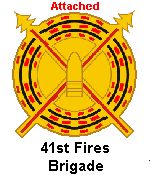
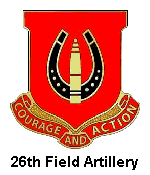
"A" Btry, 26th Field Artillery
Organizational Legacy
"Courage And Action"


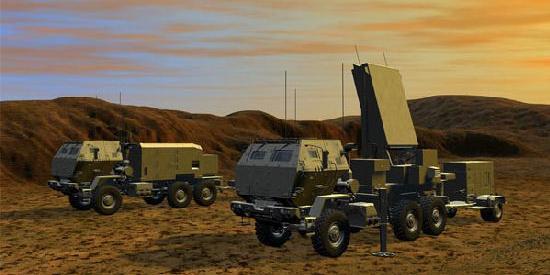 |
|---|
| EQ-26 Auxilery And Motor FireFinder Replacement System |
|---|

Regimental Distinctive Unit Insignia
 Introduction
Introduction


 The 1st Cavalry Division, a major subordinate command of the US Third Mobile
Armored Corps, is a 19,000 soldier, heavy armored division stationed at Ft.
Hood, TX. As one of the two "on-call" heavy contingency force divisions of the
Army, the First Team has an on-order mission to deploy by sea, air or land to
any part of the world on a short notice. The following narratives, divided in
timeline eras of major operational missions, describes the threat environment,
tactical conditions, evolution of equipment technology and the strategic
methodology employed by one of its command units, the 41st Fires Brigade and
its Subordinate Units, to contribute to the successful missions enhancement of
the warring organization of the 1st Cavalry Division and the honors they
achieved are summarized in the chapters that follow.
The 1st Cavalry Division, a major subordinate command of the US Third Mobile
Armored Corps, is a 19,000 soldier, heavy armored division stationed at Ft.
Hood, TX. As one of the two "on-call" heavy contingency force divisions of the
Army, the First Team has an on-order mission to deploy by sea, air or land to
any part of the world on a short notice. The following narratives, divided in
timeline eras of major operational missions, describes the threat environment,
tactical conditions, evolution of equipment technology and the strategic
methodology employed by one of its command units, the 41st Fires Brigade and
its Subordinate Units, to contribute to the successful missions enhancement of
the warring organization of the 1st Cavalry Division and the honors they
achieved are summarized in the chapters that follow.
Mission:
 The mission of the Target Acquisition Battery (TAB) is to detect, identify,
and locate enemy forces in the division area of operations or area of interest
with sufficient accuracy for attack by friendly units.
The mission of the Target Acquisition Battery (TAB) is to detect, identify,
and locate enemy forces in the division area of operations or area of interest
with sufficient accuracy for attack by friendly units.
Capabilities
The Target Acquisition Battery can acquire indirect fire targets by using its
organic weapons locating radars. It can acquire enemy moving targets and
provide surveillance with its organic moving-target-locating radar. A
counterfire officer and a target processing section are provided to the Fires
Brigade or Division Artillery to help the Artillery Counterfire Officer. To
enable assets to accurately locate targets, Target Acquisition Battery survey
sections provide prescribed survey elements to the Division survey section as
required.
Organizational Summary:
United States Artillery can be traced back to the Military Company of
Massachusetts, which was chartered in 1638, and with other colonial artillery
companies formed what became the Continental Artillery. More than a century
later, in April 1775, the legislature authorized the formation of an artillery
regiment. This unit was first commanded by Colonel Richard Gridley, a former
British artillery officer who later was replaced by Colonel Henry Knox.
Colonel Knox eventually became the Chief of Artillery and is credited with
shaping artillery tactics for the remainder of the Revolution.
 From the historical battlefields of Yorktown and Gettysburg, through the
Western Plains, Mexican and Spanish American Wars, the artillery was always
there. In fact, the nickname, "Redlegs", comes from that era when artillery
uniforms had a 2-inch red stripe on their trousers and horse artillery men
wore red canvas leggings. Continuing through the modern days of the European
and Asian Theaters of WWII, the Pusan Perimeter in Korea, the Ia Drang Valley
in Vietnam, to the "Steel Rain" of Desert Storm, "Redlegs" have served with
distinction and valor in all of our country's armed conflicts.
From the historical battlefields of Yorktown and Gettysburg, through the
Western Plains, Mexican and Spanish American Wars, the artillery was always
there. In fact, the nickname, "Redlegs", comes from that era when artillery
uniforms had a 2-inch red stripe on their trousers and horse artillery men
wore red canvas leggings. Continuing through the modern days of the European
and Asian Theaters of WWII, the Pusan Perimeter in Korea, the Ia Drang Valley
in Vietnam, to the "Steel Rain" of Desert Storm, "Redlegs" have served with
distinction and valor in all of our country's armed conflicts.
|
|
|---|
| AN_TPQ-36 Artillery And Motor FireFinder |
|---|
 The mechanical support of Target and Artillery Locating
Acquisition began in world War I and now covers the envelope of electronic
detection, identification, and location of a target in sufficient detail to
permit the effective employment of lethal and non-lethal means. The term is used for a broad area of
applications.
The mechanical support of Target and Artillery Locating
Acquisition began in world War I and now covers the envelope of electronic
detection, identification, and location of a target in sufficient detail to
permit the effective employment of lethal and non-lethal means. The term is used for a broad area of
applications.
 Technically target acquisition may just denote the process of a weapon system
to decide which object to lock on to, as opposed to surveillance on one and
target tracking on the other side; for example in an anti-aircraft system.
Technically target acquisition may just denote the process of a weapon system
to decide which object to lock on to, as opposed to surveillance on one and
target tracking on the other side; for example in an anti-aircraft system.
 Un the field, a "target" is an entity or object considered for possible
engagement or other action. Targets include a wide array of resources that an
enemy commander can use to conduct operations including mobile and stationary
units, forces, equipment, capabilities, facilities, persons and functions. It
may comprise Target Acquisition, Joint Targeting or Information
Operations.
Un the field, a "target" is an entity or object considered for possible
engagement or other action. Targets include a wide array of resources that an
enemy commander can use to conduct operations including mobile and stationary
units, forces, equipment, capabilities, facilities, persons and functions. It
may comprise Target Acquisition, Joint Targeting or Information
Operations.
 The target aquisition and Identification capabilities of Field Artillery
lays a key role in the targeting process. Without accurate targeting data,
indirect fire systems are of limited value. Weapons Locating Radars (WLR) are
one of the primary means of locating enemy indirect fire systems. Tasks for
WLRs are integrated into the Intelligence Plan (ICP) developed during the
phase of the targeting process. Radar taskings are identified in the radar
execution matrix of the Target Field Artillery Support Plan (FASP)
The target aquisition and Identification capabilities of Field Artillery
lays a key role in the targeting process. Without accurate targeting data,
indirect fire systems are of limited value. Weapons Locating Radars (WLR) are
one of the primary means of locating enemy indirect fire systems. Tasks for
WLRs are integrated into the Intelligence Plan (ICP) developed during the
phase of the targeting process. Radar taskings are identified in the radar
execution matrix of the Target Field Artillery Support Plan (FASP)
 When appropriate, tasks are noted for special actions at specific points in
the battle. Specific functions of Weapons Locating Radars (WLRs) include:
When appropriate, tasks are noted for special actions at specific points in
the battle. Specific functions of Weapons Locating Radars (WLRs) include:
Locating enemy indirect systems and generating artillery target
intelligence.
Locating enemy indirect fire systems and generating fire missions.
Registering and adjusting friendly artillery and mortars.
Validating the location of friendly fires.
Providing target intelligence and information to allow friendly
forces to take force protection measures while generating fire.
missions to attack enemy indirect fire systems.
 World War I, Continental US
World War I, Continental US

 The roots of "A" Batterey, 26th Field Artillery can be traced back to 05 July
1918, when it was constituted in the National Army as an element of the 9th
Division On 02 August it was organized at Camp McClellan, Alabama. The
regiment served within the continental limits of the United States during
World War I and was demobilized on 09 February 1919, at Camp McClellan,
Alabama. In 1923, the 26th Field Artillery was reconstituted as an inactive
unit of the Regular Army and allotted to the Fourth Corps Area.
The roots of "A" Batterey, 26th Field Artillery can be traced back to 05 July
1918, when it was constituted in the National Army as an element of the 9th
Division On 02 August it was organized at Camp McClellan, Alabama. The
regiment served within the continental limits of the United States during
World War I and was demobilized on 09 February 1919, at Camp McClellan,
Alabama. In 1923, the 26th Field Artillery was reconstituted as an inactive
unit of the Regular Army and allotted to the Fourth Corps Area.
 World War II, European Theater
World War II, European Theater

 On 01 August 1940 it was reactivated as part of the Field Artillery, Ninth
Infantry Division, First Army, at Fort Bragg in North Carolina. On 01 October
1940, the three battalions of the 26th Field Artillery were re-designated as
Artillery, and the old first battalion then became the 26th Field Artillery
Battalion.
On 01 August 1940 it was reactivated as part of the Field Artillery, Ninth
Infantry Division, First Army, at Fort Bragg in North Carolina. On 01 October
1940, the three battalions of the 26th Field Artillery were re-designated as
Artillery, and the old first battalion then became the 26th Field Artillery
Battalion.
 As of today, the 26th Field Artillery Regiment is currently represented by the
following active Units:
As of today, the 26th Field Artillery Regiment is currently represented by the
following active Units:
- "A" Battery (Target Acquisition), 41st Fires Brigade, III Corps,
stationed at Fort Hood, Texas.
- "B" Battery (Target Acquisition), 212th Fires Brigade, III Corps,
stationed at Fort Bliss, Texas.
- "C" Battery (Target Acquisition), 75th Fires Brigade, III Corps,
stationed at Fort Sill, Oklahoma.
- "D" Battery (Target Acquisition), 18th Fires Brigade, XVIII
Airborne Corps, stationed at Fort Bragg, North Carolina.
- "F" Battery (Target Acquisition), 17th Fires Brigade, I Corps,
stationed at Fort Lewis, Washington.
- "H" Battery (Target Acquisition), 214th Fires Brigade, III Corps,
stationed at Fort Sill, Oklahoma.
 The above listing of 26th Field Artillery Regiment active
units and their brigade assignments is at its best - may be inaccurate.
Visitor submissions of updated linage data is encouraged.
The above listing of 26th Field Artillery Regiment active
units and their brigade assignments is at its best - may be inaccurate.
Visitor submissions of updated linage data is encouraged.
To Be continued ...............


 This folio of material highlights of the many subsequent historical critical
missions performed by members of the 21nd Field Artillery, whose actions,
operations and the many critical issues resolved over its 96+ years history
to meet the changing threat and the honors they achieved are summarized in the
following sections:
This folio of material highlights of the many subsequent historical critical
missions performed by members of the 21nd Field Artillery, whose actions,
operations and the many critical issues resolved over its 96+ years history
to meet the changing threat and the honors they achieved are summarized in the
following sections:
 Table of Contents
Table of Contents
















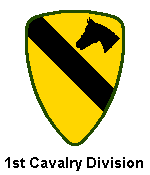



 If none of the data that you have found by surfing the reference unit chapter
titles and indexes measures up to your interests, you may want to deploy the
R&S (Reconnaissance and Surveillance) Scouts to search and identify keywords
or subjects within individual unit pages. Enter the descriptive keyword or
search terms(s) in the input field and "Click" on the Search button to screen the multiple DataBases of
the Cavalry OutPost and the garrisoned occupants - "The 1st Cavalry Division
and its Subordinate Units".
If none of the data that you have found by surfing the reference unit chapter
titles and indexes measures up to your interests, you may want to deploy the
R&S (Reconnaissance and Surveillance) Scouts to search and identify keywords
or subjects within individual unit pages. Enter the descriptive keyword or
search terms(s) in the input field and "Click" on the Search button to screen the multiple DataBases of
the Cavalry OutPost and the garrisoned occupants - "The 1st Cavalry Division
and its Subordinate Units".
 The search action will open the "first-team.us WebSite - R&S Scout Report",
which displays a listing of WebSite Titles and HTML Summaries that contain the
specific search term(s) of interest. To review any that best depicts a match
of your search term(s), "Click" on the WebSite Title to open a New Window.
After the WebSite is fully loaded, use the browser [EDIT/Find] Tool Button to
locate the search term within the page. After reviewing, close the New Window
to return to the listing of WebSites.
The search action will open the "first-team.us WebSite - R&S Scout Report",
which displays a listing of WebSite Titles and HTML Summaries that contain the
specific search term(s) of interest. To review any that best depicts a match
of your search term(s), "Click" on the WebSite Title to open a New Window.
After the WebSite is fully loaded, use the browser [EDIT/Find] Tool Button to
locate the search term within the page. After reviewing, close the New Window
to return to the listing of WebSites.
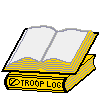



 If this is your first review of the Outpost of the 1st Cavalry Division and
its Subordinate Units, you may want to record your own report on your findings
during your visit, or perhaps you may want to review the log entries of other
visitors.
If this is your first review of the Outpost of the 1st Cavalry Division and
its Subordinate Units, you may want to record your own report on your findings
during your visit, or perhaps you may want to review the log entries of other
visitors.

To report on your findings,
"click" on the "Report-In"
Index Tab of the Troop Log. |
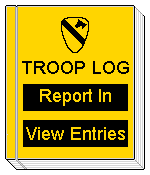
|

To review entries of others,
"Click"on the "View Entries"
Index Tab of the Troop Log. |
|---|

 As you journey through the history of the 1st Cavalry Division and its
assigned elements, you may find it interesting enough to send a message to
your friends and extend them an invitation for the opportunity to review the
rich history of the Division. We have made it easy for you to do. All that is
required is for you to click on the Push Button below, fill in their eMail
addresses and send.
As you journey through the history of the 1st Cavalry Division and its
assigned elements, you may find it interesting enough to send a message to
your friends and extend them an invitation for the opportunity to review the
rich history of the Division. We have made it easy for you to do. All that is
required is for you to click on the Push Button below, fill in their eMail
addresses and send.


|
The TITLE and URL of this WebSite are automatically read, formatted
and entered into your standard eMail form. |
|
|
Note - The eMail Message is processed and transmitted On-Line to the
addressee(s) via your Internet Provider.
Copyright © 2002, Cavalry Outpost Publications ® |




 eMail Your WebSite Comments.
eMail Your WebSite Comments.


 Return to "MyOwnPages"©.
Return to "MyOwnPages"©.

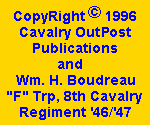 Copyright © 1996, Cavalry Outpost Publications ® and
Trooper Wm. H. Boudreau, "F" Troop, 8th Cavalry Regiment (1946 - 1947). All
rights to this body of work are reserved and are not in the public domain, or
as noted in the bibliography. Reproduction, or transfer by electronic means,
of the History of the 1st Cavalry Division, the subordinate units or any
internal element, is not permitted without prior authorization. Readers are
encouraged to link to any of the pages of this Web site, provided that proper
acknowledgment attributing to the source of the data is made. The information
or content of the material contained herein is subject to change without
notice.
Copyright © 1996, Cavalry Outpost Publications ® and
Trooper Wm. H. Boudreau, "F" Troop, 8th Cavalry Regiment (1946 - 1947). All
rights to this body of work are reserved and are not in the public domain, or
as noted in the bibliography. Reproduction, or transfer by electronic means,
of the History of the 1st Cavalry Division, the subordinate units or any
internal element, is not permitted without prior authorization. Readers are
encouraged to link to any of the pages of this Web site, provided that proper
acknowledgment attributing to the source of the data is made. The information
or content of the material contained herein is subject to change without
notice.
Revised 21 Nov '12 SpellChecked






 Introduction
Introduction















 Copyright © 1996
Copyright © 1996